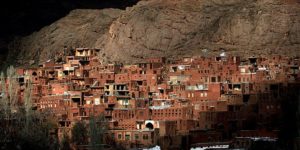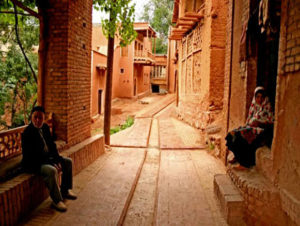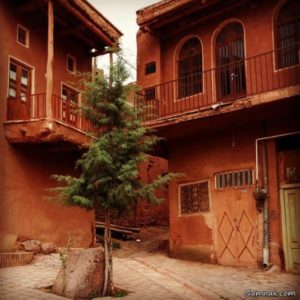Abyaneh village is one of the tourist attractions in Isfahan Province, located 40km from Natanz. As a tangible cultural heritage with an age-old history and unique architecture, the village attracts many tourists from all over the world each year.
Abyaneh’s history goes back to at least 1,500 years and is one of the earliest human settlements in the Dasht-e Kavir region of central Iran.
Abyaneh historic village has been able to attract the attention of art and history enthusiasts to this region. If you ever make a trip to Iran, make sure you visit this fabulous attraction, destinationiran.com wrote.

**Abyaneh village architecture
The village is situated on the northwestern slope of Mount Karkas between Kashan and Isfahan near Barzrud River. Opinions vary about the special architecture of Abyaneh. It has multi-storey houses which appear to be like several independent sections. Since there is not enough space on the mountain slope, the architects have chosen this type of architecture. Of course, there are also similar examples of such architecture for instance those in Paveh (Kermanshah Province) and Masouleh (Gilan Province).
The houses of this multi-storey village are built on the hillside as if placed on a stairway. This breathtaking architecture, which provides the image of the labyrinth for visitors, attracts numerous Iranian and foreign tourists every year.
The village was one of the earliest human settlements in Iran. So, naturally, several cultures and civilizations have influenced it throughout history. However, art and history enthusiasts can easily grasp the consolidated architectural style of the village.
Abyaneh has also benefited from the designs of Sasanian architecture which are evident at Firoozabad in Fars Province. Now, the architecture of the Abyaneh historic village, which was influenced by the art of the Sassanians, Seljuks, Safavids, etc., is known as one of the wonderful tourist attractions of Isfahan Province and plays a key role in the region’s tourism.
In the architecture of this village, the local people have used sun-dried bricks and wood. The architects of Abyaneh have been able to make the best use of fired and sun-dried bricks in the construction.
The roofs, ceilings, door frames, windows and terraces of the houses are mostly made of wood. The arch-shaped doorways and windows have added beauty to the houses of this village and provided a spectacular environment. This design along with the narrow passageways and streets has given astonishing views to Abyaneh.
The unified architecture of the village attracts the attention of tourists and visitors alike. The houses are located as if placed on a stairway. The roofs of some houses serve as the courtyard for another house higher up on the slope. This feature helps make optimum use of land and space. On the other hand, the exterior façade of walls of the buildings is covered with adobe-color clay.

**Abyaneh culture and tradition
The exclusive culture and traditions of the inhabitants of Abyaneh are the other reason for its reputation. Native people have fully protected the values and traditions of their ancestors. And you can still see the traditional costume and local clothing in this village.
Native people speak their own local dialect. Abyaneh is one of those villages that has retained their own particular religious and ritual ceremonies, especially Muharram ceremonies, which are the best example of this intangible cultural heritage.
Apart from its fantastic history, Abyaneh village has a beautiful nature with arable land and hardworking people with remarkable commitment. The large number of gardens in Abyaneh have contributed to its prosperous agriculture, gardening, and livestock breeding. Thus, they have all provided a suitable condition for creating relatively good income for its inhabitants.
In addition, carpet weaving is also a source of income for women and girls in this village. It has provided the ground for some entrepreneurs in this region.
**Historical monuments
There are many historical shrines, mausoleums, and monuments which form an integral part of the rich collection of Abyaneh’s tangible cultural heritage. Native people and tourists visit Bibi Zobeideh Mausoleum — a major religious site in Abyaneh Village. The mausoleum of Bibi Zobeideh, who was related to Imam Musa Kazim (PBUH), the seventh Shia Imam, is also located in the southeast of this village.
There are other mausoleums belonging to Yahya and Isa at the eastern part of the village who were the sons of Imam Musa Kazim (PBUH). There is a difference between the architectural style of these two pilgrimage sites and that of the whole village. The main feature of this mausoleum is its vast courtyard, pool, and a conical dome. Architects have designed this beautiful structure with turquoise tiles.
These Islamic edifices, especially the Jame’ Mosque, have played a significant role in religious aspects and intangible cultural heritage of Abyaneh. The floor of the Shabestān (praying hall) is made of wood which has made it quite different. The wooden mehrab is the most significant religious element of Abyaneh remaining from the Seljuk period. It’s been decorated with images of flowers and plants and Qur’anic verses from the chapter Yaseen.
The mosque has been restored in recent years and is one of the most remarkable religious monuments of this village.
What makes Abyaneh Village a powerful magnet attracting many to itself is the traditional ambiance, beautiful nature and exclusive architecture of the village that attract the attention of domestic and international tourists.


Good blog you’ve got here.. It’s difficult to find good quality writing like yours
nowadays. I seriously appreciate people like you! Take care!!
Magnificent site. Plenty of useful information here.
I am sending it to several pals ans also sharing in delicious.
And of course, thank you to your sweat!